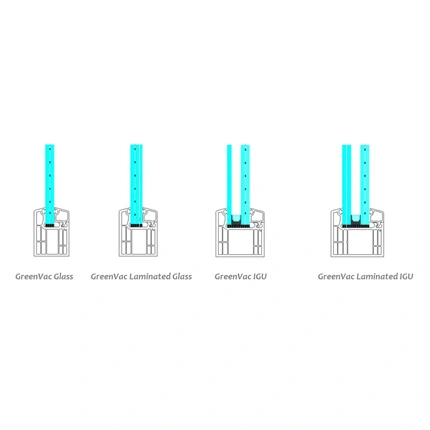
Vacuum insulated glass (VIG) is a type of glazing that uses a vacuum between two panes of glass to insulate a building. Our vacuum glass supplier provides VIG that is much more efficient than traditional double- or triple-paned glass, and can help to reduce energy costs by up to 30%.
VIG is made by creating a vacuum between two panes of glass. The panes of glass are then sealed together to create a hermetic seal. The vacuum prevents heat from transferring between the two panes of glass, which makes VIG much more efficient than traditional glazing.
VIG is available in a variety of types and finishes, and can be used for a variety of purposes. It can be used in windows, doors, skylights, and curtain walls. VIG can also be used in furniture and art. For large-scale projects, VIG can be produced in glass bulk to meet substantial construction demands efficiently.
As one of the professional vacuum insulated glass suppliers and vacuum insulated glass manufacturers in China, we offer affordable vacuum glass price. Contact us now!
Thickness | 3/3, 4/4, 5/5. 6/6 + 12A/15A/19A/22A + Temp / Lami ; |
Maximum size | 1500 x 3600 mm |
Special shapes | Oval, arch, triangle, half arch and more |
U-Value | 0.27 W/(m².K) |
Acoustic performance | 42-45=48(-2;-4) Rw (C; Ctr)(dB) |
LT – Light transmission | 44-75% or above |
Low emissivity coating | Yes, in accordance with EN 1096 / EN 12150-1 / EN 14449 /EN 1279 |
Construction and Principle
VIG: Vacuum Insulated Glass consists of two panes of glass separated by a vacuum gap, which is typically less than 0.5 mm. The edges are sealed with a hermetic seal, and spacers are placed between the glass panes to prevent them from touching. The vacuum gap eliminates conductive and convective heat transfer, significantly improving insulation.
Traditional IGUs: These units are made of two or more glass panes separated by a spacer and sealed around the edges. The space between the glass panes is filled with air or inert gases like argon or krypton. The gases reduce heat transfer more effectively than regular air but not as efficiently as the vacuum in VIG.
Thermal Performance
VIG: Offers superior thermal insulation due to the vacuum between the glass panes, which almost entirely eliminates air molecules and thus, conductive and convective heat transfer. This results in a significantly lower U-value (a measure of heat loss) compared to traditional IGUs.
Traditional IGUs: While the use of inert gas and multiple glass layers improves thermal performance over single-pane glass, IGUs cannot match the insulation efficiency of VIG. The presence of gas, even though it's less conductive than air, still allows for some level of heat transfer.
Low Thermal Conductivity: Vacuum insulated glass has extremely low thermal conductivity, which helps to prevent heat loss during the winter and heat gain during the summer. This results in improved indoor comfort and energy savings year-round.
Reduced Condensation: The vacuum-sealed gap in vacuum insulated glass minimizes the risk of condensation forming between the glass panes, reducing the potential for mold growth, moisture damage, and visibility obstruction.
Sound Insulation: Vacuum insulated glass offers improved sound insulation compared to single-pane windows, reducing the transmission of airborne noise from outside. The vacuum-sealed gap acts as a buffer, dampening vibrations and minimizing sound transmission.
Environmental Benefits: Vacuum insulated glass contributes to environmental sustainability by reducing energy consumption for heating and cooling. Its superior thermal insulation properties help lower carbon emissions associated with building operation.
Customization Options: Vacuum insulated glass can be customized to meet specific size, shape, and performance requirements for different architectural projects. It can be incorporated into various window and facade systems to achieve both aesthetic and functional goals.
Pls contact us if you have any inquire or questions, thank you.
No.12111, JINGSHI ROAD, LIXIA DIST, JINAN CITY, SHANDONG PROVINCE, CHINA